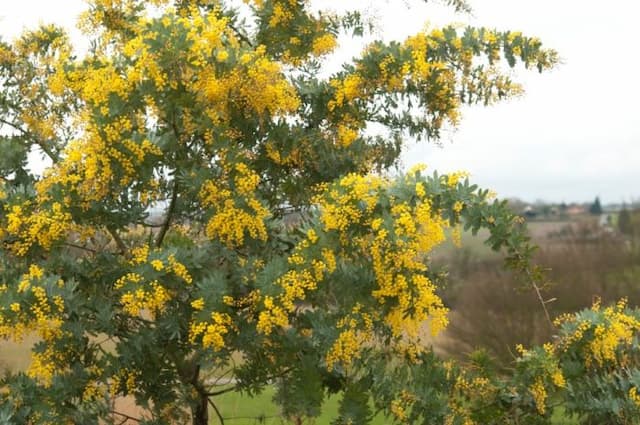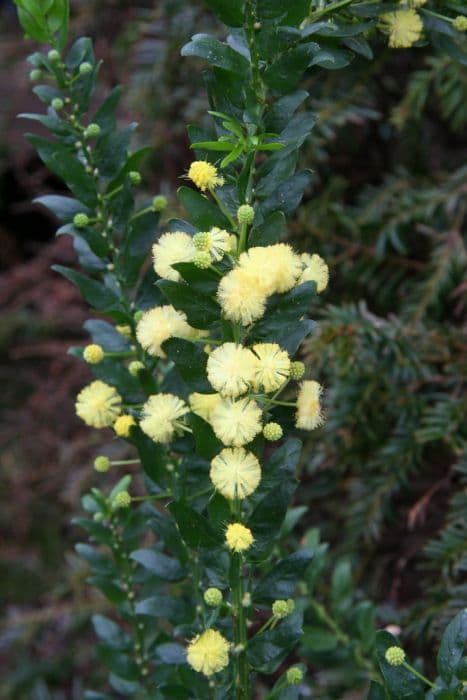White clover Trifolium repens

ABOUT
White clover, commonly known as Trifolium repens, is a perennial plant with a creeping habit, spreading across the ground with stems that root at intervals, giving it a sturdy grip on the soil. The leaves are compound, typically grouping in sets of three leaflets, which is a characteristic feature symbolized by the "tri" in its name, denoting "three", and "folium" meaning "leaf". Each leaflet is rounded, often with a lighter or white crescent or "V" marking, and the edges are finely toothed. As a defining feature, white clover produces small, rounded flower heads that appear to be pom-poms and are typically white, though they can sometimes have a pinkish hue. These clusters of tiny flowers are profuse and attract a variety of pollinators including bees. White clover is often seen in lawns, meadows, and as ground cover, as it can tolerate being mowed or grazed. Its presence is particularly noticeable in temperate regions and it is often associated with the classic imagery of rolling green fields speckled with white blossoms.
About this plant
 Names
NamesFamily
Fabaceae
Synonyms
White Clover, Dutch Clover, Ladino Clover, Ladino
Common names
Trifolium repens var. giganteum, Trifolium lenormandii, Trifolium occidentale, Trifolium repens subsp. macrorrhizum, Trifolium repens subsp. nevadense, Trifolium repens var. nevadense, Trifolium repens var. prostratum, Trifolium repens subsp. repens, Trifolium repens var. typicum, Trifolium repens var. atropurpureum, Trifolium repens var. repens.
 Toxicity
ToxicityTo humans
White clover is not considered toxic to humans when consumed in small quantities. However, like many plants, if consumed in large amounts, it can potentially cause issues due to its mild ability to cause bloating, especially in its raw form. Generally, white clover is considered safe and has been used traditionally in various cultures as a salve or tea. There are no severe toxic consequences of ingesting white clover for humans under normal circumstances.
To pets
White clover is typically not toxic to pets, such as dogs and cats. However, it can produce mild gastrointestinal symptoms if consumed in large quantities. Clover can also ferment in the stomach, causing gas and discomfort for the animal. Pets with a particular sensitivity may exhibit mild symptoms such as drooling, nausea, or diarrhea. In general, the ingestion of white clover does not lead to severe toxicity or long-term health consequences for pets.
 Characteristics
CharacteristicsLife cycle
Perennials
Foliage type
Evergreen
Color of leaves
Green
Flower color
White
Height
6 inches (15 cm)
Spread
1 foot (30 cm)
Plant type
Herb
Hardiness zones
4
Native area
Europe
Benefits
 General Benefits
General Benefits- Nitrogen Fixation: Trifolium repens, commonly known as white clover, is a leguminous plant that can fix atmospheric nitrogen, thereby enriching soil fertility without the need for chemical fertilizers.
- Soil Improvement: Its deep roots help to break up heavy soils and improve soil structure, promoting better water infiltration and aeration.
- Erosion Control: The dense mat of white clover aids in preventing soil erosion on slopes and in areas prone to erosion due to its spreading growth habit.
- Grazing: It is a valuable forage crop for livestock, providing a high-protein feed that improves animal health and productivity.
- Biodiversity: It supports a variety of wildlife, particularly pollinators such as bees, which find it a rich source of nectar.
- Lawn Alternative: White clover can be used in lawn mixtures to create a low-maintenance, drought-tolerant ground cover that remains green even in poor soil conditions.
- Weed Suppression: It can outcompete weeds, reducing the need for herbicides in agricultural and garden settings.
- Aesthetic Appeal: With its white flowers, white clover adds beauty to landscapes and serves as a cover crop that enhances visual appeal of an area.
 Medical Properties
Medical Properties- Anti-inflammatory: Trifolium repens, commonly known as white clover, has been used in traditional medicine for its potential anti-inflammatory properties.
- Expectorant: It is believed to act as an expectorant, helping to relieve coughs by loosening mucus in the airways.
- Wound healing: White clover has been used topically in some traditional medicine practices to aid in the healing of wounds.
- Diuretic: It is sometimes used as a diuretic to help increase urine flow and relieve fluid retention.
- Gout relief: There are historical references to its use in reducing symptoms associated with gout, such as pain and swelling.
- Respiratory health: White clover has been used to address respiratory conditions, likely due to its expectorant qualities.
 Air-purifying Qualities
Air-purifying QualitiesThis plant is not specifically known for air purifying qualities.
 Other Uses
Other Uses- Soil Improvement: Trifolium repens, commonly known as white clover, is often used in crop rotations for its ability to fix nitrogen in the soil, thereby improving soil fertility for subsequent plantings.
- Erosion Control: Its dense and spreading growth habit makes white clover an effective ground cover for stabilizing soil and reducing erosion on slopes and banks.
- Lawn Alternative: White clover can be used as a low-maintenance lawn alternative that remains green and requires less water and no fertilizers.
- Wildlife Habitat: It provides food for pollinators like bees and butterflies, and its flowers and leaves serve as a food source for various wildlife species.
- Forage Crop: White clover is widely used as a forage crop for livestock, providing a high-protein food source for grazing animals like cows and sheep.
- Living Mulch: When planted between rows of crops, white clover acts as a living mulch, suppressing weeds and conserving soil moisture.
- Cover Crop: Farmers often plant white clover as a cover crop to protect bare soil in winter, since it can grow in cooler temperatures and provide ground cover.
- Biological Pest Control: White clover can attract beneficial insects that prey on crop pests, effectively acting as a form of biological pest control.
- Green Manure: As a green manure, it is plowed into the soil to decay, providing organic matter and nutrients for future plants.
- Recreational Use: White clover is sometimes included in grass seed mixes for sports fields because it is durable and can withstand heavy foot traffic.
Interesting Facts
 Feng Shui
Feng ShuiThe White Clover is not used in Feng Shui practice.
 Zodiac Sign Compitability
Zodiac Sign CompitabilityThe White Clover is not used in astrology practice.
 Plant Symbolism
Plant Symbolism- Good Luck: Trifolium repens, commonly known as white clover, traditionally symbolizes good luck, especially if you find one with four leaves, as the rarity of such a find is considered fortuitous.
- Prosperity: Due to its association with good luck, white clover is also tied to prosperity and the idea of abundance, suggesting a flourishing or positive outcome.
- Love: White clover is often linked to love, with each leaf representing a different aspect such as hope, faith, love, and luck for a four-leaf clover.
- Protection: In some traditions, white clover is believed to ward off negative spirits or provide protection against harm, making it a charm for safety.
- Growth and Vitality: The vigorous growth habit of white clover signifies the themes of growth and vitality, suggesting an ever-expanding or rejuvenating aspect of life.
- Trinity: The three leaves of a typical white clover plant have been connected to the Christian concept of the Trinity, symbolizing the Father, Son, and Holy Spirit.
 Water
WaterWhite clover, or Trifolium repens, should be watered deeply but infrequently to encourage a strong root system. Generally, you need to water white clover about once a week, providing approximately 1 inch of water per session. During periods of high heat or drought, water every 3 to 5 days. In cooler weather or when rainfall is adequate, you may reduce watering frequency. Make sure the soil is allowed to dry out slightly between watering sessions to prevent root rot. Use a rain gauge to help measure the inch of water, or about 0.62 gallons, you apply to the area where the clover grows.
 Light
LightWhite clover prefers full sun but can tolerate partial shade. The best spot for white clover is an area where it will receive at least six hours of sunlight a day. However, it can still perform well with less direct sun exposure; some afternoon shade can be beneficial in hotter climates to prevent scorching.
 Temperature
TemperatureWhite clover thrives in temperatures between 60 and 85 degrees Fahrenheit. This plant can survive temperatures as low as 5 degrees Fahrenheit and as high as 90 degrees Fahrenheit but may become dormant in extremes. The ideal temperature range promotes healthy growth and abundant flowering.
 Pruning
PruningPruning white clover can help maintain its shape and encourage denser growth. Prune or mow white clover during the growing season if it becomes too tall or begins to encroach on other plants. The best time for pruning is in the early spring or after flowering to keep its spread in check and to remove any dead or damaged foliage.
 Cleaning
CleaningNot needed
 Soil
SoilWhite clover thrives in well-drained loam or clay soils with a pH between 6.0 and 7.0. A balanced mix containing equal parts of loam, sand, and organic compost or peat moss is ideal to ensure the soil stays fertile and aerated.
 Repotting
RepottingWhite clover typically does not require repotting as it is a perennial ground cover that spreads through stolons. If grown in containers, repot every 2-3 years to refresh soil and manage growth.
 Humidity & Misting
Humidity & MistingWhite clover prefers moderate humidity levels but is adaptable to various conditions. It does well in average garden environments without the need for specific humidity adjustments.
 Suitable locations
Suitable locationsIndoor
Ensure bright light, infrequent watering, and ample airflow.
Outdoor
Plant in full sun to partial shade, and water moderately.
Hardiness zone
4-9 USDA
 Life cycle
Life cycleTrifolium repens, commonly known as white clover, begins its life cycle with seed germination, typically in the spring, where it requires moisture and a suitable temperature to sprout. The seedlings establish a root system and produce leaves to photosynthesize, forming a small rosette close to the ground. As the plant matures, it develops a spreading habit through its creeping stems, called stolons, which root at nodes to form new clonal plants. White clover flowers usually in late spring or early summer, producing rounded heads of white or occasionally pink flowers which are pollinated by various insects, particularly bees. Following pollination, the plant produces tiny seeds within small pods that are dispersed by wind, water, or animal movement, ultimately closing the reproductive cycle. The plant is a perennial, so after seed production, the vegetative parts may persist and continue to grow until conditions become unfavorable, at which point it can survive in a dormant state until favorable conditions return.
 Propogation
PropogationPropogation time
Spring to early summer
Propogation: White clover, or Trifolium repens, can be propagated most effectively through seeding. The best time for sowing white clover seeds is typically in the spring or fall when the soil is moist and the temperatures are mild, supporting germination and growth. To propagate by seeding, first prepare the soil by raking and clearing debris to create a fine seedbed. Broadcast the seeds evenly across the soil surface at a rate of approximately 2 to 4 ounces per 1,000 square feet (56 to 113 grams per 92.9 square meters). Lightly rake the seeds into the soil to ensure they’re covered but no deeper than 1/4 inch (6.4 millimeters). Keep the soil consistently moist until germination, which usually occurs within two weeks. Once established, white clover spreads easily on its own through a network of rhizomes, making it an ideal ground cover or addition to lawn mixes.









